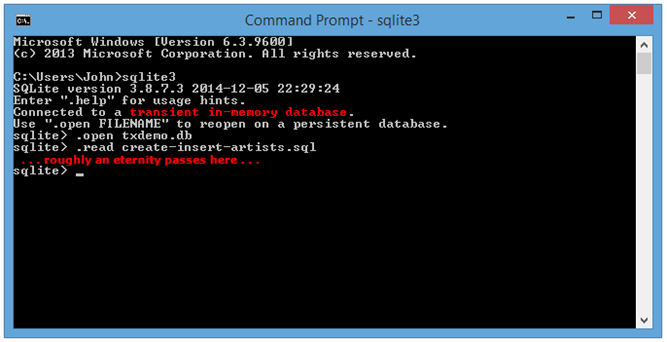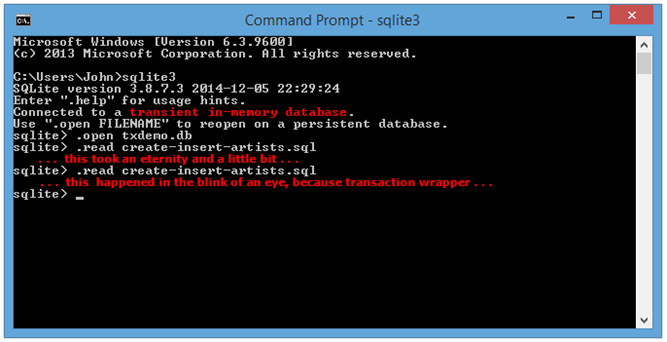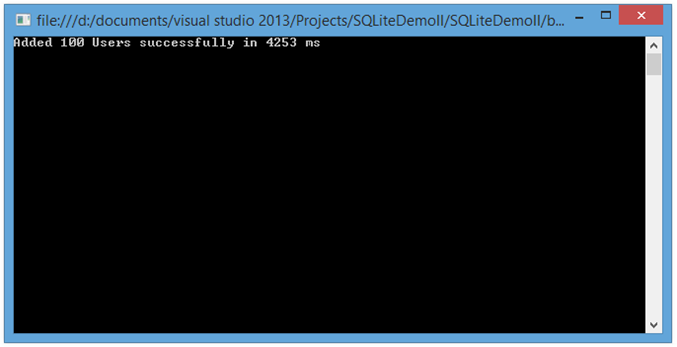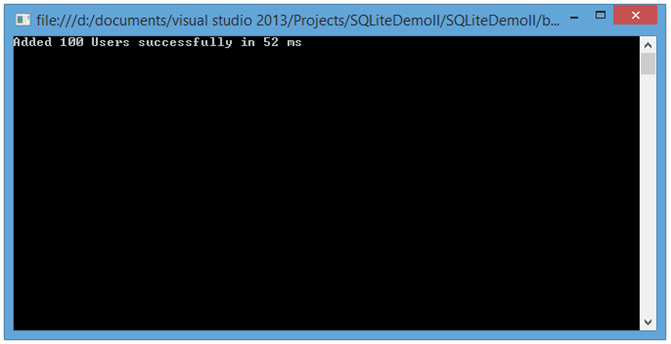Image by Lance McCord | Some Rights Reserved
If you are new to SQLite, you may well run across one of the most confounding of its implementation details the moment you attempt to do some sort of bulk or batch processing of inserts or updates. What you will discover is that unless properly implemented, inserting or updating multiple records in a SQLite database can seem abysmally slow. Slow to the point of unsuitability in certain cases.
Not to fear, this has to do with some default (and not entirely improper) design choices in SQLite, for which there is an easy workaround.
SQLite is a wonderfully simple to use, cross-platform/open source database with terrific performance specs. It is a mature product, and, if we are to believe the estimates of SQLite.org, is the most widely deployed SQL database in the world. SQLite manages to cram a host of mature, well-developed features into a compact and well-documented package, including full transaction support.
This transaction support, and the way it is implemented, has a significant impact on certain performance characteristics of SQLite.
- Installing and Using SQLite on Windows
- Batch Processing in SQLite – A Console Example
- Add Transactions to SQLite Scripts Using BEGIN and COMMIT
- Improve SQLite Performance in Your .NET Application Using Transactions
- Sample .NET Application – The Slow, Hard Way
- Wrap SQLite Batch Operations in an ADO Transaction in Your .NET Application
- Be Cautious with Your Transactions in SQLite
- Additional Resources and Items of Interest
Transactions by Default in SQLite
As stated previously, one of the selling points of SQLite, despite it being a simple, file-based database, is that it is fully transactional. What does this mean?
From Wikipedia:
A transaction comprises a unit of work performed within a database management system (or similar system) against a database, and treated in a coherent and reliable way independent of other transactions. Transactions in a database environment have two main purposes:
- To provide reliable units of work that allow correct recovery from failures and keep a database consistent even in cases of system failure, when execution stops (completely or partially) and many operations upon a database remain uncompleted, with unclear status.
- To provide isolation between programs accessing a database concurrently. If this isolation is not provided, the program’s outcome are possibly erroneous.
A database transaction, by definition, must be atomic, consistent, isolated and durable.[1] Database practitioners often refer to these properties of database transactions using the acronym ACID.
Transactions provide an “all-or-nothing” proposition, stating that each work-unit performed in a database must either complete in its entirety or have no effect whatsoever. Further, the system must isolate each transaction from other transactions, results must conform to existing constraints in the database, and transactions that complete successfully must get written to durable storage.
SQLite is not alone, of course, in implementing transactions – in fact, transactions are a core concept in database design. However, the implementation of SQLite proposes that, unless otherwise specified, each individual write action against your database (any action through which you modify a record) is treated as an individual transaction.
In other words, if you perform multiple INSERT (or UPDATEs, or DELETEs) in a “batch,” each INSERT will be treated as a separate transaction by SQLite.
The trouble is, transactions carry processing overhead. When we decide we need to perform multiple INSERTs in a batch, we can run into some troubling performance bottlenecks.
Batch Processing in SQLite – A Console Example
If we are using SQLite from the SQLite Console, we can see exactly what I am talking about by running an easy insert script, and seeing how things go. For this example, I borrowed a few lines from the Chinook Database to create and populate a table of Artists. If you don’t have the SQLite Command Line Console on your machine, install it now (see Installing and Using SQLite on Windows for details). Then copy the SQL script from my Gist on Github, paste it into a text file, and save the file in your user folder as create-insert-artists.sql.
The script should look like this in the text file before you save:
Paste the SQL Script Into a Text File and Save:
DROP TABLE IF EXISTS [Artist];
CREATE TABLE [Artist]
(
[ArtistId] INTEGER NOT NULL,
[Name] NVARCHAR(120),
CONSTRAINT [PK_Artist] PRIMARY KEY ([ArtistId])
);
INSERT INTO [Artist] ([ArtistId], [Name]) VALUES (1, 'AC/DC');
INSERT INTO [Artist] ([ArtistId], [Name]) VALUES (2, 'Accept');
INSERT INTO [Artist] ([ArtistId], [Name]) VALUES (3, 'Aerosmith');
INSERT INTO [Artist] ([ArtistId], [Name]) VALUES (4, 'Alanis Morissette');
-- . . . A bunch more artist records . . .
INSERT INTO [Artist] ([ArtistId], [Name]) VALUES (273, 'C. Monteverdi, Nigel Rogers
INSERT INTO [Artist] ([ArtistId], [Name]) VALUES (274, 'Nash Ensemble');
INSERT INTO [Artist] ([ArtistId], [Name]) VALUES (275, 'Philip Glass Ensemble');
If we open a new database in the SQLite Console (navigate to your User folder to do this for our purposes here) and read the script, we can see how long it takes. There are 275 Artist records in the script to be INSERTED.
Run SQLite3, Open a New Database, and Read the Artists Script:
Microsoft Windows [Version 6.3.9600] (c) 2013 Microsoft Corporation. All rights reserved. C:\Users\John>sqlite3 SQLite version 3.8.7.3 2014-12-05 22:29:24 Enter ".help" for usage hints. Connected to a transient in-memory database. Use ".open FILENAME" to reopen on a persistent database. sqlite> .open txdemo.db sqlite> .read create-insert-artists.sql
We can see that (depending on your machine – your mileage may vary) executing the script takes roughly 10 seconds. Inserting 275 records should NOT take 10 seconds. Ever.
Console Output from Running Script (Took Way Too Long!):
As mentioned previously, unless we tell it otherwise, SQLite will treat each of those INSERT commands as an individual transaction, which slows things WAAAYYYY DOOOOWWWWN. We can do better. We tell SQLite to override this behavior by explicitly specifying our own transaction, beginning before the INSERT batch, and committing after each INSERT batch.
Add Transactions to SQLite Scripts Using BEGIN and COMMIT
When we are executing batches of INSERTs, UPDATEs, or DELETEs in a script, wrap all the writes against each table up in a transaction using the BEGIN and COMMIT SQLite Keywords. Modify the create-insert-artists.sql script in out text file by adding a BEGIN before the table INSERTs, and a COMMIT after the table inserts (for scripts involving more than one table, do this for the INSERTs for each table):
Modified Script Wraps INSERTs in single transaction:
DROP TABLE IF EXISTS [Artist];
CREATE TABLE [Artist]
(
[ArtistId] INTEGER NOT NULL,
[Name] NVARCHAR(120),
CONSTRAINT [PK_Artist] PRIMARY KEY ([ArtistId])
);
BEGIN;
INSERT INTO [Artist] ([ArtistId], [Name]) VALUES (1, 'AC/DC');
INSERT INTO [Artist] ([ArtistId], [Name]) VALUES (2, 'Accept');
INSERT INTO [Artist] ([ArtistId], [Name]) VALUES (3, 'Aerosmith');
INSERT INTO [Artist] ([ArtistId], [Name]) VALUES (4, 'Alanis Morissette');
-- . . . A bunch more artist records . . .
INSERT INTO [Artist] ([ArtistId], [Name]) VALUES (273, 'C. Monteverdi, Nigel Rogers
INSERT INTO [Artist] ([ArtistId], [Name]) VALUES (274, 'Nash Ensemble');
INSERT INTO [Artist] ([ArtistId], [Name]) VALUES (275, 'Philip Glass Ensemble');
COMMIT;
If we re-run our script now, we see a significant performance boost. In fact, the script execution is nearly immediate.
Re-Run the Script in the SQLite Console (this time, with a Transaction):
The above will apply to all INSERTs, UPDATEs, and DELETEs when you execute scripts in the SQLite console.
Improve SQLite Performance in Your .NET Application Using Transactions
We see a similar problem when we use SQLite in a .NET application, and the solution is conceptually the same, although the implementation is necessarily a little different. If you are new to using SQLite (and many .NET developers are, at some point), this is exactly the type of confounding quirk that can have you running back to yet another “integrated” Microsoft database solution before giving this great database a chance. “I tried SQLite, but the inserts and updates were too damn slow . . .”
Sample .NET Application – The Slow, Hard Way
Consider the following Console application example. It is a small, simplistic example, and has no exception handling, but you get the idea. The Main() method performs some basic set-up, then builds a List<User> which is passed to the AddUsers() method.
Program to Insert a List of Users Using System.Data.SQLite:
class Program
{
static string _connectionString;
static void Main(string[] args)
{
// 'Data' directory in the current directory ( ..\bin\Debug\):
string dbDirectory = Environment.CurrentDirectory;
string dbName = "test.db";
// Add System.IO to the using statements at the top of your code file:
string dbPath = Path.Combine(dbDirectory, dbName);
_connectionString = string.Format("Data Source = {0}", dbPath);
CreateDbIfNotExists(dbPath);
CreateUsersTable();
int qtyToAdd = 100;
// Load some users into a list...
var usersToAdd = new List<User>();
for(int i = 0; i < qtyToAdd; i++)
{
usersToAdd.Add(new User { Name = "User #" + i });
}
// And THEN add them:
var sw = new System.Diagnostics.Stopwatch(); ;
sw.Start();
int qtyAdded = AddUsers(usersToAdd);
sw.Stop();
Console.WriteLine("Added {0} Users successfully in {1} ms",
qtyAdded, sw.ElapsedMilliseconds);
var allUsers = ReadUsers();
Console.WriteLine("Read {0} Users from SQLite", allUsers.Count());
Console.Read();
}
static void CreateDbIfNotExists(string dbPath)
{
string directory = Path.GetDirectoryName(dbPath);
if (!File.Exists(dbPath))
{
// Creates directory if it doesn't already exist:
Directory.CreateDirectory(directory);
// Creates file if it doesn't already exist:
SQLiteConnection.CreateFile(dbPath);
}
}
static SQLiteConnection CreateConnection()
{
return new SQLiteConnection(_connectionString);
}
static void CreateUsersTable()
{
string sqlTestTable =
@"CREATE TABLE IF NOT EXISTS Users
(
Id INTEGER PRIMARY KEY AUTOINCREMENT,
Name TEXT NOT NULL
)";
using (var cn = new SQLiteConnection(_connectionString))
{
using (var cmd = new SQLiteCommand(sqlTestTable, cn))
{
cn.Open();
cmd.ExecuteNonQuery();
cn.Close();
}
}
}
class User
{
public int Id { get; set; }
public string Name { get; set; }
}
static int AddUsers(IEnumerable<User> users)
{
var results = new List<int>();
string sqlInsertUsers =
@"INSERT INTO Users (Name) VALUES (@0);";
using (var cn = new SQLiteConnection(_connectionString))
{
// Open the connection, and also atransaction:
cn.Open();
using(var transaction = cn.BeginTransaction())
{
foreach (var user in users)
{
using (var cmd = cn.CreateCommand())
{
cmd.CommandText = sqlInsertUsers;
cmd.Parameters.AddWithValue("@0", user.Name);
results.Add(cmd.ExecuteNonQuery());
}
}
transaction.Commit();
}
cn.Close();
}
return results.Sum();
}
}
The AddUsers() method creates a connection and a command, opens the connection, and then iterates over the IEnumerable<User>, successively inserting the user data for each into the SQLite database. We are using a System.Diagnostics.Stopwatch to time the execution of the call to AddUsers() from Main().
It looks like we’ve done everything right here – we set up the connection only once, open it only once (opening and closing connections for each loop iteration causes its own performance hit). However, it still takes upwards of four seconds to insert only 100 users. We can see the results in our console output.
Console Output from Example Program Inserting 100 Users:
Pretty lame, but not surprising, given what we have learned about transactionality defaults in SQLite. but, once again, we can do better.
Wrap SQLite Batch Operations in an ADO Transaction in Your .NET Application
Similar to using the SQLite console, the solution here is also to use a transaction. We can modify the code in the AddUsers() method as follows:
Modified Code for AddUsers() Method Wrapping Command Execution in a Transaction:
static int AddUsers(IEnumerable<User> users)
{
var results = new List<int>();
string sqlInsertUsers =
@"INSERT INTO Users (Name) VALUES (@0);";
using (var cn = new SQLiteConnection(_connectionString))
{
// Open the connection, and also atransaction:
cn.Open();
using(var transaction = cn.BeginTransaction())
{
foreach (var user in users)
{
using (var cmd = cn.CreateCommand())
{
cmd.CommandText = sqlInsertUsers;
cmd.Parameters.AddWithValue("@0", user.Name);
results.Add(cmd.ExecuteNonQuery());
}
}
transaction.Commit();
}
cn.Close();
}
return results.Sum();
}
With that, if we run our application again, we see an order of magnitude performance improvement:
Improved SQLite Insert Performance Using Transaction in .NET:
Yep. 52 milliseconds, down from over 4,000 milliseconds.
Be Cautious with Your Transactions in SQLite
We’ve seen how we can realize some serious performance wins in SQLite by using transactions to wrap up bulk operations. However, let’s not put the cart before the horse without thinking it through. Sometimes, you actually need a more granular level of transaction to ensure data integrity.
It simply would not do to maximize performance of a banking application if transactions were implemented only at the top level of a batch operation. After all, transactions in the world of relational databases are first and foremost about creating assurance that an operation succeed in its entirety, or not at all.
Additional Resources and Items of Interest
- Installing and Using SQLite on Windows
- Configuring Db Connection and Code-First Migration for Identity Accounts in ASP.NET MVC 5 and Visual Studio 2013
- Setting Up Linux in a Virtual Machine for Windows Users
- C#: Query Excel and .CSV Files Using LinqToExcel
- C#: Create and Manipulate Word Documents Programmatically Using DocX




Comments
 Inspector
Inspector
AuthorJust wanted to let you know, the “4sec” and “52ms” C# code are identical.
You should probably fix that because it makes the post far less useful.
Though since the post is years old, it probably has done quite a bit of damage already.
 John Atten
John Atten
AuthorWell THAT’s annoying. I’ll fix it up. RE: “Though since the post is years old, it probably has done quite a bit of damage already.” Not sure what “damage” you’re speaking of at least the code for both is the “better” way to do it. All that said, thanks for pointing it out. Damn. Cheers!
 Shakir. K.
Shakir. K.
AuthorI chose a random article of yours to say something irrelevant to this specific post..
I follow your tutorials since your older site typecastexception.. I have always asked myself why doesnt he publish a book?
Your way of explaining things is marvellous.. You know how to start with basics sometimes, so beginners can catch up with you..
I share one common thing with you.. I spend time and money for learning programming and it is till now just a hobby, although i am thinking seriously to shift my career.
So thank you for sharing your thoughts! and let me wish that you do your visitors a favour:
I wish you add an index page for all your posts. Bec. Paging them alone means you burry important posts deeply inside the server making it hard to find.
Regards Shakir
 John Atten
John Atten
AuthorHi Ahmet –
Sad to hear, but lessons learned, right?
Yup. I always test against different sized data sets, even if I don't ever expect to see more than a few hundred records. Ya just never know!
Thanks for reading, and taking the time to comment!
 AhmetA
AhmetA
AuthorHi John ;
I wish I could read this article 3 months before. In a hurry, I developed a file processing solution using SQLite.
In production environment input file grow to huges sizes, ~100K lines per file. I tested it only with small files, thats 200-300 lines per file.
So production environment hit by slow inserts in SQLite. Project is cancelled and we lost a customer. Shame on me.